LCDR Bruce Avery Van Voorhis, 35, USN (1908–1943)
VP-102
Greenwich Island, Solomon Islands
July 6, 1943
Presented August 1, 1946
Posthumous
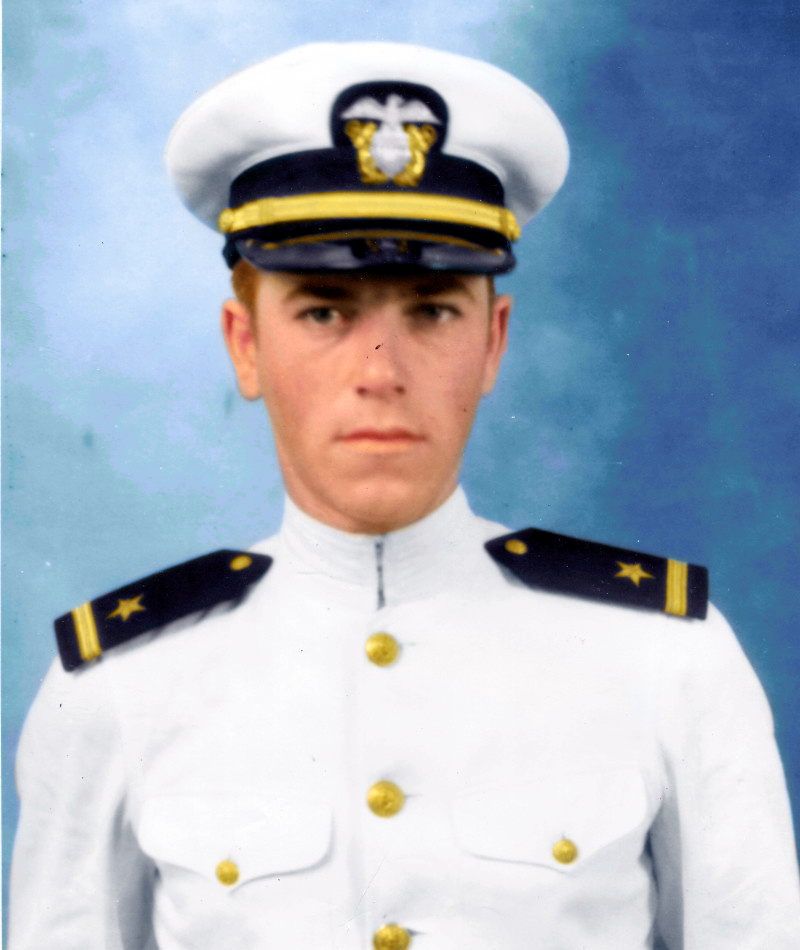
(1929-30)
The President of the United States of America, in the name of Congress, takes pride in presenting the Medal of Honor (posthumously) to LCDR Bruce Avery Van Voorhis, United States Navy, for conspicuous gallantry and intrepidity at the risk of his life above and beyond the call of duty as squadron commander of Bombing Squadron 102 and as plane commander of a PB4Y-1 patrol bomber operating against the enemy on Japanese-held Greenwich Island during the battle of the Solomon Islands, July 6, 1943.
Fully aware of the limited chance of surviving an urgent mission, voluntarily undertaken to prevent a surprise Japanese attack against our forces, LCDR Van Voorhis took off in total darkness on a perilous 700-mile flight without escort or support. Successful in reaching his objective despite treacherous and varying winds, low visibility, and difficult terrain, he fought a lone but relentless battle under fierce anti-aircraft fire and overwhelming aerial opposition. Forced lower and lower by pursuing planes, he coolly persisted in his mission of destruction. Abandoning all chances of a safe return, he executed six bold, ground-level attacks to demolish the enemy’s vital radio station, installations, anti-aircraft guns and crews with bombs and machine-gun fire, and to destroy one fighter plane in the air and three on the water. Caught in his own bomb blast, LCDR Van Voorhis crashed into the lagoon off the beach, sacrificing himself in a singlehanded fight against almost insuperable odds, to make a distinctive contribution to our continued offensive in driving the Japanese from the Solomons and, by his superb daring, courage, and resoluteness of purpose, enhanced the finest traditions of the U.S. Naval Service. He gallantly gave his life for his country.
2 Likes
ENS John Joseph Parle, 23, USNR (1920–1943)
USS LST 375
Off Sicily, Italy
July 9-10, 1943
Presented January 26, 1944
Posthumous

The President of the United States of America, in the name of Congress, takes pride in presenting the Medal of Honor (posthumously) to ENS John Joseph Parle, United States Naval Reserve, for valor and courage above and beyond the call of duty as Officer-in-Charge of Small Boats in the USS LST-375 during the amphibious assault on the island of Sicily, July 9-10, 1943.
Realizing that a detonation of explosives would prematurely disclose to the enemy the assault about to be carried out, and with full knowledge of the peril involved, ENS Parle unhesitatingly risked his life to extinguish a smoke pot accidentally ignited in a boat carrying charges of high explosives, detonating fuses and ammunition. Undaunted by fire and blinding smoke, he entered the craft, quickly snuffed out a burning fuse, and after failing in his desperate efforts to extinguish the fire pot, finally seized it with both hands and threw it over the side. Although he succumbed a week later from smoke and fumes inhaled, ENS Parle’s heroic self-sacrifice prevented grave damage to the ship and personnel and insured the security of a vital mission. He gallantly gave his life in the service of his country.
1 Like
2LT Robert Craig, 24, USA (1919–1943)
Company L, 15th Infantry Regiment, 3rd Infantry Division
Near Favarotta, Sicily, Italy
July 11, 1943
Authorized May 26, 1944
Posthumous
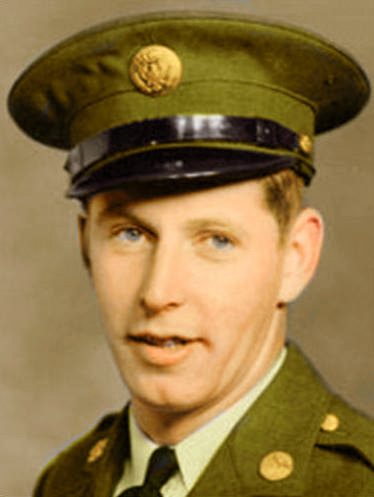
The President of the United States of America, in the name of Congress, takes pride in presenting the Medal of Honor (posthumously) to 2LT Robert Craig, United States Army, for conspicuous gallantry and intrepidity at the risk of his life above and beyond the call of duty, on July 11, 1943, at Favarotta, Sicily.
2LT Craig voluntarily undertook the perilous task of locating and destroying a hidden enemy machine gun which had halted the advance of his company. Attempts by three other officers to locate the weapon had resulted in failure, with each officer receiving wounds. 2LT Craig located the gun and snaked his way to a point within 35 yards of the hostile position before being discovered. Charging headlong into the furious automatic fire, he reached the gun, stood over it, and killed the three crew members with his carbine. With this obstacle removed, his company continued its advance. Shortly thereafter, while advancing down the forward slope of a ridge, 2LT Craig and his platoon, in a position devoid of cover and concealment, encountered the fire of approximately 100 enemy soldiers. Electing to sacrifice himself so that his platoon might carry on the battle, he ordered his men to withdraw to the cover of the crest while he drew the enemy fire to himself. With no hope of survival, he charged toward the enemy until he was within 25 yards of them. Assuming a kneeling position, he killed five and wounded three enemy soldiers. While the hostile force concentrated fire on him, his platoon reached the cover of the crest. 2LT Craig was killed by enemy fire, but his intrepid action so inspired his men that they drove the enemy from the area, inflicting heavy casualties on the hostile force.
1 Like
1LT David Crowder Waybur, 23, USA (1919–1945)
3rd Reconnaissance Troop, 3rd Infantry Division
Near Agrigento, Sicily, Italy
July 17, 1943
Presented November 29, 1943

The President of the United States of America, in the name of Congress, takes pleasure in presenting the Medal of Honor to 1LT (Inf) David Crowder Waybur (ASN: 0-452653), United States Army, for conspicuous gallantry and intrepidity at the risk of life above and beyond the call of duty in action involving actual conflict with the enemy.
Commander of a reconnaissance platoon, 1LT Waybur volunteered to lead a 3-vehicle patrol into enemy-held territory to locate an isolated Ranger unit. Proceeding under cover of darkness, over roads known to be heavily mined, and strongly defended by road blocks and machinegun positions, the patrol’s progress was halted at a bridge which had been destroyed by enemy troops and was suddenly cut off from its supporting vehicles by four enemy tanks. Although hopelessly outnumbered and outgunned, and himself and his men completely exposed, he quickly dispersed his vehicles and ordered his gunners to open fire with their .30- and .50-caliber machine guns. Then, with ammunition exhausted, three of his men hit and himself seriously wounded, he seized his .45-caliber Thompson submachine gun and standing in the bright moonlight directly in the line of fire, alone engaged the leading tank at 30 yards and succeeded in killing the crewmembers, causing the tank to run onto the bridge and crash into the stream bed. After dispatching one of the men for aid, he rallied the rest to cover and withstood the continued fire of the tanks till the arrival of aid the following morning.
1 Like
2LT John Cary “Red” Morgan, 28, USAAF (1914–1991)
326 BS, 92 BG, 8th Air Force
Over Kiel, Germany
July 28, 1943
Presented December 19, 1943
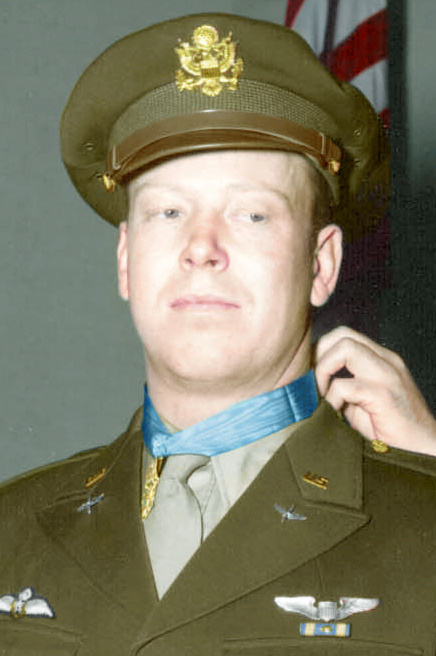
The President of the United States of America, in the name of Congress, takes pleasure in presenting the Medal of Honor to 2LT (Air Corps) John Cary “Red” Morgan (ASN: 0-2044877), United States Army Air Forces, for conspicuous gallantry and intrepidity above and beyond the call of duty, while participating on a bombing mission over enemy-occupied continental Europe, July 28, 1943.
Prior to reaching the German coast on the way to the target, the B-17 airplane in which 2LT Morgan was serving as copilot was attacked by a large force of enemy fighters, during which the oxygen system to the tail, waist, and radio gun positions was knocked out. A frontal attack placed a cannon shell through the windshield, totally shattering it, and the pilot’s skull was split open by a .303-caliber shell, leaving him in a crazed condition. The pilot fell over the steering wheel, tightly clamping his arms around it. 2LT Morgan at once grasped the controls from his side and, by sheer strength, pulled the airplane back into formation despite the frantic struggles of the semiconscious pilot. The interphone had been destroyed, rendering it impossible to call for help. At this time the top turret gunner fell to the floor and down through the hatch with his arms shot off at the shoulder and a gaping wound in his side. The waist, tail, and radio gunners had lost consciousness from lack of oxygen and, hearing no fire from their guns, the copilot believed they had bailed out. The wounded pilot still offered desperate resistance in his crazed attempts to fly the airplane. There remained the prospect of flying to and over the target and back to a friendly base wholly unassisted. In the face of this desperate situation, 2LT Morgan made his decision to continue the flight and protect any members of the crew who might still be in the ship and for two hours he flew in formation with one hand at the controls and the other holding off the struggling pilot before the navigator entered the steering compartment and relieved the situation. The miraculous and heroic performance of 2LT Morgan on this occasion resulted in the successful completion of a vital bombing mission and the safe return of his airplane and crew.
2 Likes
2LT Robert Sheldon Scott, 29, USA (1913–1999)
1st Platoon, Company C, 1st Battalion, 172nd Infantry Regiment, 43rd Infantry Division
Near Munda Airstrip, New Georgia, Solomon Islands
July 29, 1943
Presented October 14, 1944

The President of the United States of America, in the name of Congress, takes pleasure in presenting the Medal of Honor to CPT (Inf) Robert Sheldon Scott, United States Army, for conspicuous gallantry and intrepidity at the risk of his life above and beyond the call of duty near Munda Airstrip, New Georgia, Solomon Islands, on July 29, 1943.
After 27 days of bitter fighting, the enemy held a hilltop salient which commanded the approach to Munda Airstrip. Our troops were exhausted from prolonged battle and heavy casualties, but 2LT Scott advanced with the leading platoon of his company to attack the enemy position, urging his men forward in the face of enemy rifle and enemy machinegun fire. He had pushed forward alone to a point midway across the barren hilltop within 75 yards of the enemy when the enemy launched a desperate counterattack, which if successful would have gained undisputed possession of the hill. Enemy riflemen charged out on the plateau, firing and throwing grenades as they moved to engage our troops. The company withdrew, but 2LT Scott, with only a blasted tree stump for cover, stood his ground against the wild enemy assault. By firing his carbine and throwing the grenades in his possession he momentarily stopped the enemy advance using the brief respite to obtain more grenades. Disregarding small-arms fire and exploding grenades aimed at him, suffering a bullet wound in the left hand and a painful shrapnel wound in the head after his carbine had been shot from his hand, he threw grenade after grenade with devastating accuracy until the beaten enemy withdrew. Our troops, inspired to renewed effort by 2LT Scott’s intrepid stand and incomparable courage, swept across the plateau to capture the hill, and from this strategic position four days later captured Munda Airstrip.
2 Likes
PFC Frank Joseph Petrarca, 23, USA (1918–1943)
Medical Detachment, 145th Infantry Regiment, 37th Infantry Division
Horseshoe Hill, New Georgia, Solomon Islands
July 27-31, 1943
Presented December 23, 1943
Posthumous
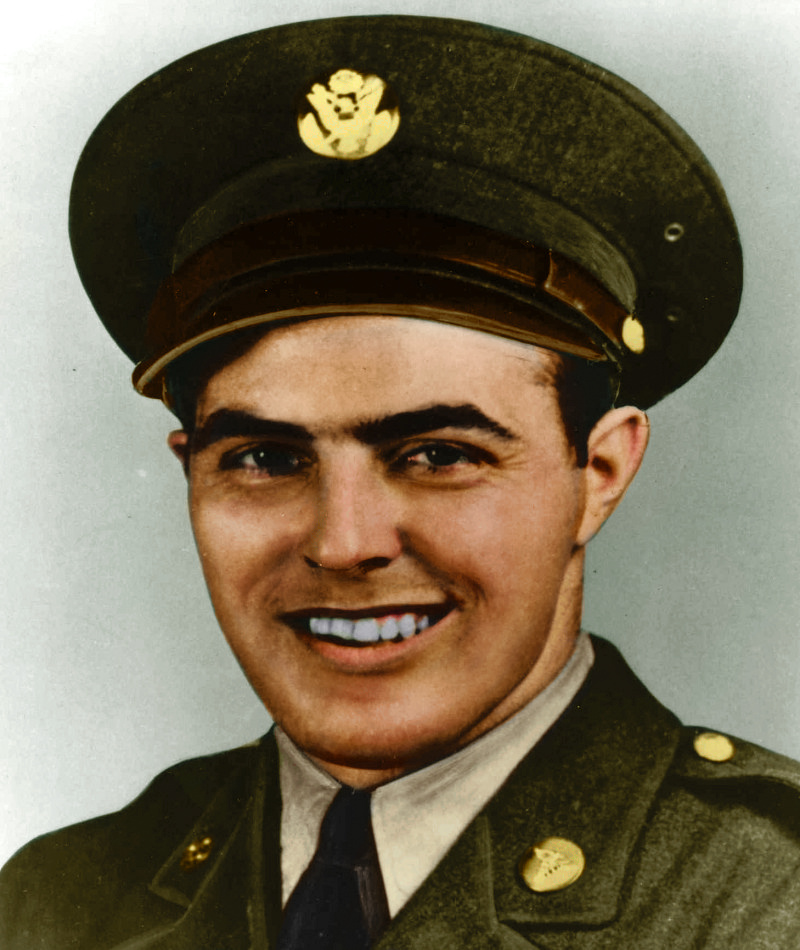
The President of the United States of America, in the name of Congress, takes pride in presenting the Medal of Honor (posthumously) to PFC Frank Joseph Petrarca, United States Army, for conspicuous gallantry and intrepidity in action above and beyond the call of duty.
PFC Petrarca advanced with the leading troop element to within 100 yards of the enemy fortifications where mortar and small-arms fire caused a number of casualties. Singling out the most seriously wounded, he worked his way to the aid of PFC Scott, lying within 75 yards of the enemy, whose wounds were so serious that he could not even be moved out of the direct line of fire. PFC Petrarca fearlessly administered first aid to Pfc. Scott and two other soldiers and shielded the former until his death. On July 29, 1943, PFC Petrarca, during an intense mortar barrage, went to the aid of his sergeant who had been partly buried in a foxhole under the debris of a shell explosion, dug him out, restored him to consciousness, and caused his evacuation. On July 31, 1943 and against the warning of a fellow soldier, he went to the aid of a mortar fragment casualty where his path over the crest of a hill exposed him to enemy observation from only 20 yards distance. A target for intense knee mortar and automatic fire, he resolutely worked his way to within two yards of his objective where he was mortally wounded by hostile mortar fire. Even on the threshold of death he continued to display valor and contempt for the foe; raising himself to his knees, this intrepid soldier shouted defiance at the enemy, made a last attempt to reach his wounded comrade and fell in glorious death.
2 Likes
SGT Gerry Herman Kisters, 24, USA (1919–1986)
Company B, 91st Reconnaissance Squadron, 2nd Armored Division – attached to the 1st Infantry Division
Near Gagliano, Sicily, Italy
July 31, 1943
Presented February 8, 1944
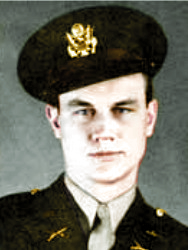
The President of the United States of America, in the name of Congress, takes pleasure in presenting the Medal of Honor to 2LT Gerry Herman Kisters (ASN: 35150942), United States Army, for conspicuous gallantry and intrepidity in action above and beyond the call of duty while serving with Company B, 91st Reconnaissance Squadron, attached to the 1st Infantry Division.
On July 31, 1943, near Gagliano, Sicily, a detachment of one officer and nine enlisted men, including SGT Kisters, advancing ahead of the leading elements of U.S. troops to fill a large crater in the only available vehicle route through Gagliano, was taken under fire by two enemy machine guns. SGT Kisters and the officer, unaided and in the face of intense small-arms fire, advanced on the nearest machine-gun emplacement and succeeded in capturing the gun and its crew of four. Although the greater part of the remaining small-arms fire was now directed on the captured machine-gun position, SGT Kisters voluntarily advanced alone toward the second gun emplacement. While creeping forward, he was struck five times by enemy bullets, receiving wounds in both legs and his right arm. Despite the wounds, he continued to advance on the enemy, and captured the second machine gun after killing three of its crew and forcing the fourth member to flee. The courage of this soldier and his unhesitating willingness to sacrifice his life, if necessary, served as an inspiration to the command.
1 Like
PVT Rodger Wilton Young, 25, USA (1918–1943)
148th Infantry Regiment, 37th Infantry Division
New Georgia, Solomon Islands
July 31, 1943
Presented January 17, 1944
Posthumous
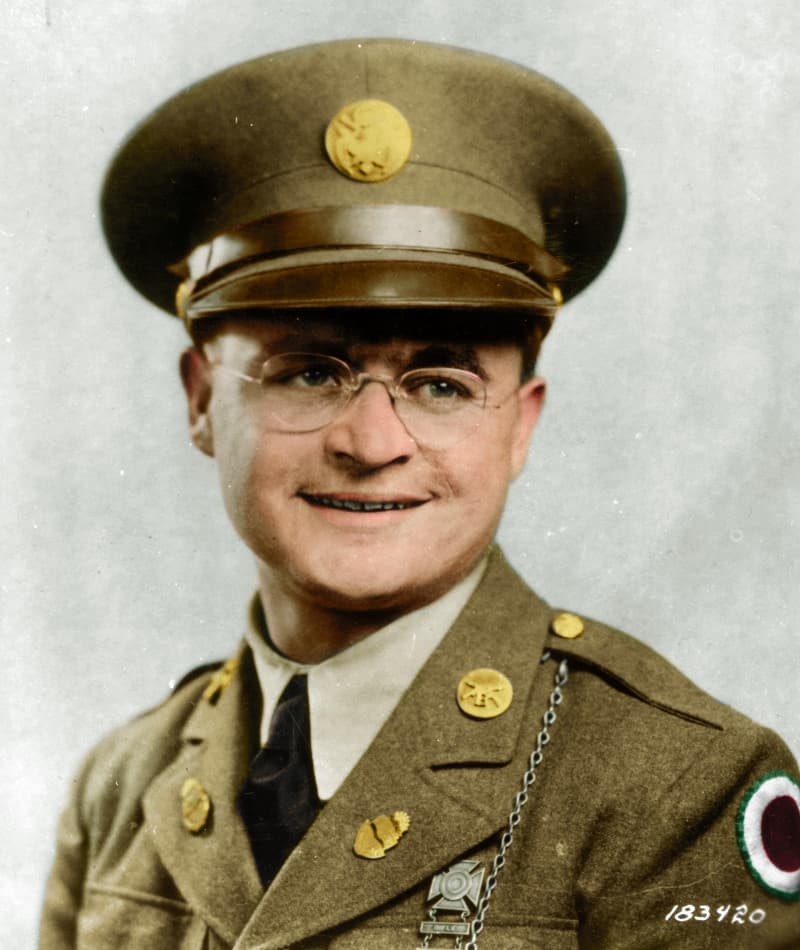
The President of the United States of America, in the name of Congress, takes pride in presenting the Medal of Honor (posthumously) to PVT Rodger W. Young (ASN: 20504613), United States Army, for conspicuous gallantry and intrepidity in action above and beyond the call of duty while serving with 148th Infantry Regiment, 37th Infantry Division, in action at New Georgia, Solomon Islands.
On July 31, 1943, the infantry company of which PVT Young was a member, was ordered to make a limited withdrawal from the battle line in order to adjust the battalion’s position for the night. At this time, PVT Young’s platoon was engaged with the enemy in a dense jungle where observation was very limited. The platoon suddenly was pinned down by intense fire from a Japanese machine gun concealed on higher ground only 75 yards away. The initial burst wounded PVT Young. As the platoon started to obey the order to withdraw, PVT Young called out that he could see the enemy emplacement, whereupon he started creeping toward it. Another burst from the machine gun wounded him the second time. Despite the wounds, he continued his heroic advance, attracting enemy fire and answering with rifle fire. When he was close enough to his objective, he began throwing hand grenades, and while doing so was hit again and killed. PVT Young’s bold action in closing with this Japanese pillbox, and thus diverting its fire, permitted his platoon to disengage itself, without loss, and was responsible for several enemy casualties.
1 Like








